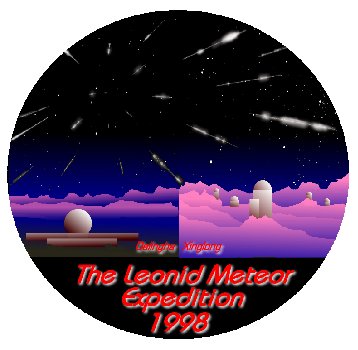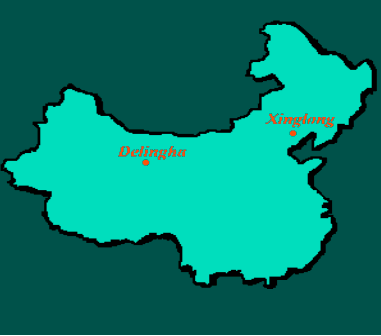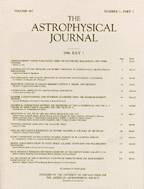 |
and is available in Adobe Acrobat PDF-format too from our DMS FTP-site. (608 kB) Groupphoto of team-members of the Sino-Dutch Leonid Expedition 1998 |
- Dutch text: Marc de Lignie, Casper ter Kuile, Carl Johannink, Ben Kokkeler
- English text: Marco Langbroek
- Design, Lay-out and Production: Robert Haas
1. Introduction
In November of 1998, astronomers are awaiting a unique opportunity to observe a very rare celestial
phenomenon. 33 Years after that last happened, comet P/Tempel-Tuttle has returned into the inner parts
of our solar system, thereby passing close to the orbit of the Earth. From such previous returns, e.g.
that of 1965/66, it is known that the Earth will traverse through the dense trail of dust released by
the comet into space.  During this traverse, which takes a few hours, the dust particles will enter our
atmosphere and will become incandescent; the friction developed when the dust particles pass trhrough
the dense atmosphere with the astronomic speed of 71 km/sec causes the particles to burn and illuminate.
The high numbers of dust particles entering our atmosphere will result in the appearance of tenthousands
of shooting stars (meteors) in the sky; this is the rare and unique phenomenon of a 'meteor storm', one
of the most astonishing events that can take place in the night sky. This century, such intense 'meteor
storms' (not to be confused with the much more modest, and much more common 'meteor showers') have only
been observed in 1933, 1946, and 1966 so far.
During this traverse, which takes a few hours, the dust particles will enter our
atmosphere and will become incandescent; the friction developed when the dust particles pass trhrough
the dense atmosphere with the astronomic speed of 71 km/sec causes the particles to burn and illuminate.
The high numbers of dust particles entering our atmosphere will result in the appearance of tenthousands
of shooting stars (meteors) in the sky; this is the rare and unique phenomenon of a 'meteor storm', one
of the most astonishing events that can take place in the night sky. This century, such intense 'meteor
storms' (not to be confused with the much more modest, and much more common 'meteor showers') have only
been observed in 1933, 1946, and 1966 so far.
2. The 1998 Leonid Meteor Expedition to China
The Dutch Meteor Society (DMS), in cooperation with the Chinese Purple Mountain Observatory (PMO) of
Nanjing, is organizing a scientific observational expedition in order to study this rare astronomic event.
Some 17 members of DMS will travel to China, the part of the World which will have the best view on the
event. They will bring with them special photographic- and video- equipment, in order to record the expected
meteor storm with scientific precision. Including test-runs of the equipment and the travel to remote
observing locations, the whole expedition will take some two weeks, with the expected meteor storm (which
is called the 'Leonids', after the constellation from which they appear in the sky) during the night of
November 17-18 as the ultimate goal.
 In order to eliminate the risk of failure due to
bad weather to the highest possible degree, separate observational networks will be established by two
geographically well-separated teams. One team will take position in the vicinity of Beijing at the Astronomical Observatory of Xinglong, the other
team will travel to remote Delingha in the Qinghai Province of central China. Both locations have the
advantage of favourable climatologic conditions in this time of the year, and by their geographic locations
offer the best possibilities to observe the meteor storm. During several nights around the date of the
expected meteor storm, the observers will challenge the nighttime cold -night-time temperatures go down to
-15m C at 3000m altitude in Delingha- in order to sample the meteor activity. Special clothing and
equipment are necessary to keep technical equipment and observers alike running under these conditions.
Needless to say, the expedition will take all efforts to ensure succesfull observations on the meteor storm.
And such a joint success of international importance will be a good base to further cooperation between
Dutch and Chinese scientists.
In order to eliminate the risk of failure due to
bad weather to the highest possible degree, separate observational networks will be established by two
geographically well-separated teams. One team will take position in the vicinity of Beijing at the Astronomical Observatory of Xinglong, the other
team will travel to remote Delingha in the Qinghai Province of central China. Both locations have the
advantage of favourable climatologic conditions in this time of the year, and by their geographic locations
offer the best possibilities to observe the meteor storm. During several nights around the date of the
expected meteor storm, the observers will challenge the nighttime cold -night-time temperatures go down to
-15m C at 3000m altitude in Delingha- in order to sample the meteor activity. Special clothing and
equipment are necessary to keep technical equipment and observers alike running under these conditions.
Needless to say, the expedition will take all efforts to ensure succesfull observations on the meteor storm.
And such a joint success of international importance will be a good base to further cooperation between
Dutch and Chinese scientists.
3. Scientific importance
The observations conducted by the expedition are designed to result in a better understanding of how
dust particles are ejected from their parent comet, how they behave as part of the interplanetary matter,
what their size distributions and orbits through the solar system are. Answers to these kind of research
questions, of which still little is known, can add considerably to the results obtained by spacecraft
missions such as the Giotto mission
to comet Halley in 1986.
 In addition, more kowledge is gained
about objects and events that can be a threath to Earth and artificial satellites. For this purpose, the
observational results obtained have to be of high accuracy. Exact timings of their appearance and high
precision photographic observations will enable computation of highly accurate orbits of the meteors,
video-observations and counts will provide accurate data on their rate of appearance and size distribution.
Employed for this purpose is photographic and video equipment specially developed for this task: arrays of
computer-controlled photographic cameras including devices to measure speeds; video cameras equiped with
image-intensifying technology that are able to film low light level phenomenon; and equipment that makes
use of scattered radio waves to detect meteor activity.
In addition, more kowledge is gained
about objects and events that can be a threath to Earth and artificial satellites. For this purpose, the
observational results obtained have to be of high accuracy. Exact timings of their appearance and high
precision photographic observations will enable computation of highly accurate orbits of the meteors,
video-observations and counts will provide accurate data on their rate of appearance and size distribution.
Employed for this purpose is photographic and video equipment specially developed for this task: arrays of
computer-controlled photographic cameras including devices to measure speeds; video cameras equiped with
image-intensifying technology that are able to film low light level phenomenon; and equipment that makes
use of scattered radio waves to detect meteor activity.
4. Cooperation with Chinese investigators
China has a long standing and rich astronomical tradition that started centuries ago. Ancient records
written in Chinese, some dating back to several centuries before the birth of Christ, provide some of this
worlds earliest historic sources about celestial phenomenon. In more modern times, Chinese astronomy
suffered from limited resources, the cultural revolution and limited communications with the international
community. That is now changing, and the predicted occurence of the unique Leonid meteor storm over China
in November of 1998 might provide a boost to further international cooperation.
The Chinese Academy of Sciences wants to take this opportunity to intensify its contacts with foreign
scientists. They choose to enter a joint programm with the Dutch Meteor Society (DMS), who has an established
expertise in this type of observations. The Dutch Meteor Society hopes to be able to encourage Chinese
efforts in meteor astronomy by offering to share some of its expertise during the Leonid meteor storm of
1998. Over the past 15 years, the Dutch Meteor Society has succesfully organized a number of observational
expeditions of this type that have yielded significant results. Currently, DMS is the worlds primary
contributor of high accuracy observational data on meteors (Acrobat-PDF via ftp-download: 260kB).
5. Media attention
An impressive celestial event like the Leonid meteor storm of 1998 is expected to attract some media
attention: when the whole sky is being filled with meteors, it looks like the Earth is moving through the
stars at high speed. This offers some prospects for media attention for our expedition too.  The event and
the expedition are expected to have news-value most notably around November 1998 and possibly also November
1999, when we expect a smaller 're-run' of the event to take place over Europe. In recent history much more
modest events of this kind and some of our earlier expeditions have been target of media attention. For the
upcoming event and expedition, we plan to intensify our media contacts by offering press releases and pictures.
One topic that is expected to arrouse some interest is the possible threath of this event to artificial satellites,
e.g. communications satellites. These must do without the protective cover supplied by our atmosphere to the
inhabitants of the Earth, and can be damaged when hit by one of the dust particles in the meteor storm.
During a much smaller meteor display in 1993, a launch of the Space-Shuttle was postponed for that reason.
The event and
the expedition are expected to have news-value most notably around November 1998 and possibly also November
1999, when we expect a smaller 're-run' of the event to take place over Europe. In recent history much more
modest events of this kind and some of our earlier expeditions have been target of media attention. For the
upcoming event and expedition, we plan to intensify our media contacts by offering press releases and pictures.
One topic that is expected to arrouse some interest is the possible threath of this event to artificial satellites,
e.g. communications satellites. These must do without the protective cover supplied by our atmosphere to the
inhabitants of the Earth, and can be damaged when hit by one of the dust particles in the meteor storm.
During a much smaller meteor display in 1993, a launch of the Space-Shuttle was postponed for that reason.
6. Sponsoring opportunities
It is clear that a project as described above demands a lot of organizational efforts and financial
support. All DMS members are non-paid volunteers who do this work besides their regular work and the DMS
activities are usually employed without permanent financial support. Members of the Dutch Meteor Society
have invested considerably into their equipment over the last few years, and for this expedition both this
equipment and a considerable number of people have to be moved over a large distance.
The China Committee of the Royal Dutch Academy of Sciences
(KNAW) is supporting the current 1998 Leonid Expedition. Funding proposals have been submitted to a number
of other non-commercial funds who have supported special DMS activities in the past.
The Dutch Meteor Society is actively solliciting support and sponsorship for the 1998 Leonid meteor storm
Expedition to China. Most notably, we are solliciting support from Dutch and international companies that
are active on the Chinese market and are positive towards the idea of promoting scientific cooperation
between China and other countries.
Sponsorship and other gifts are under the care of the Foundation Euregio Public Center for Astronomy and
are therefore tax-deducable. The Foundation has ample experience with sponsor-ships, and will guarantee a
good representation of sponsors in the project. In close cooperation with the commercial sponsors, DMS
will try to convert media attention for the project into high visibility of the project and its sponsors.
This includes posibilities for depiction of company emblems on photo- and video-materials, and mentioning
sponsorships in newspapers, astronomical magazines, scientific articles and if possible radio- and tv-items.
Supplying photographic and video materials of the expedition for promotion activities is also one of the
possibilities.
7. Information contact
For more information with regard to possible sponsorships and donations, please contact:
Dutch Meteor Society,
"project Sino-Dutch Leonid Expedition 1998"
- Hans Betlem, Lederkarper 4, NL-2318 NB Leiden, The Netherlands, Phone: +31-71-5223187
- Carl Johannink, Schiefestrasse 36, D-48599 Gronau, Germany, Phone: +49-2562-22345
- Ben Kokkeler, Otto Klempererstraat 111, NL-7558 EN Hengelo, The Netherlands, Phone: +31-74-2772199
- Casper ter Kuile, Akker 145, NL-3732 XD De Bilt, The Netherlands, Phone: +31-30-2203170
- Marc de Lignie, Prins Hendrikplein 42, NL-2264 SN Leidschendam, The Netherlands, Phone: +31-70-3205673
Intermezzo 1: The Dutch Meteor Society (DMS)
The Dutch Meteor Society, founded in 1979 by Hans Betlem, is a Society that promotes the observation of meteors ('shooting stars'). About twenty active members regularly conduct visual, photographic, video and radio-MS observations on meteors. These observations are analysed and reported on in the Societies' own bimonthly Journal 'Radiant'. In close cooperation with a number of respected foreign scientists, further analysis and reports are being published in international Scientific Journals like the Astrophysical Journal, Astronomy & Astrophysics, Meteoritics & Planetary Science etc.
 |

 |
DMS has organized a number of observational expeditions, including campaigns to observe the annual Geminid meteor stream in 1990 and the Perseid meteor outburst of 1993 from Southern France; The Leonids and the unique and important alfa Monocerotid outburst from Southeast Spain in the highly successfull expedition of 1995; and the Leonids of 1997 from the USA. The Society has its own website with timely news and results: http://home.planet.nl/~dmsweb/
Intermezzo 2: What are 'meteors'?
Meteors (or: 'shooting stars') are small dust particles with an origin in space. They are released from the nuclei of comets (e.g. like recent comet Hale-Bopp), that loose the dust when evapora-ting the outer layers of their nuclei while passing close to the Sun. Some comets move in orbits that cross very close to the orbit of the Earth: the result is that the Earth traverses through the trail of dust left by the comet in its wake. The dust particles enter the atmosphere surrounding our planet: the high speeds and air density causes friction and heat release, which makes the dust particle burn and the air around it incandescent. For a fraction of a second, this results in a streak of light shooting accross the sky: 'shooting stars'. The dust trails that cause the meteor activity are encountered each year around the same date. For example, conspicuous numbers of meteors are visible each year around January 4, August 13, November 17 and December 13. This are the so called 'annual meteor streams' or 'annual meteor showers'. The streams are called after the point in the sky from which they (due to perspective) seem to emerge: e.g. the November 17 meteors seem to emerge from the constellation Lion (Leo in Latin) and hence are called the 'Leonids'. When looking into the direction of the Lion, we are looking into the direction of the orbit of comet Tempel-Tuttle from which the dust particles originate.
Intermezzo 3: Comets, Meteor Storms, and the Leonids
Comets move in very wide orbits. Most of their time, they are at far distance from both the Sun and Earth. But when they do come close to Earth occasionally, the Earth can encounter the very dense dust cloud immediately surrounding the comet. This is the rare occasion when there is prospect for a true 'storm' or 'rain' of meteors. On an average night only 10 meteors per hour appear: during an annual meteor stream disply this can go up to several tens per hour. But on the occasion of a true 'meteor storm', thousands of meteors can appear in one hour time! The sky then becomes filled with meteors (often several per second!), a phenomenon which, according to the descriptions, must be an astonishing sight. Ancient Chinese wrote: 'At midnight, stars fell like rain'. These kind of phenomena last only short: 2-3 hours at best.
 |  University Observatory |
This century, such intense 'meteor storms' have only been observed with certainty in October of 1933 and 1946 (the Draconid stream) and November of 1966 (the Leonids), and none of these events has been recorded and studied with modern observing equipment so far. Comet P/Tempel-Tuttle (discovered in 1865/66) has an orbit that brings it close to Earth each 32-33 years. It was dust released by this comet that was responsible for the impressive meteor storm that was observed from the USA on November 17 1966. In the early spring of 1998, 33 years after its last apparition, the comet passed close to Earth again. This year and next year on November 17-18, the Earth will traverse through the dense dust clouds in the wake of the comet. From former apparitions (e.g. 1966, 1866 and 1833) it is known that the dusttrail near the comet is that dense that an astonishing meteor storm can appear with on past occasions more than 10 000 meteors having been counted in one hour. It takes the Earth only 2 hours to traverse through this dense dust trail, but the trail is long enough to produce spectacular meteor activity up to two years after the passage of the comet. That makes very good prospects for a meteor storm in 1998 and possibly also 1999. When and where we will see the storm is determined by the actual moment that the Earth meets the trail. In 1998 that will be favourable for central Asia (China), in 1999 for east Europe.